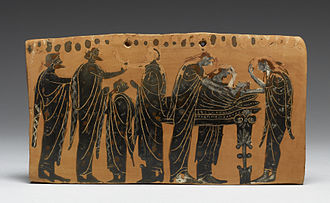Pottery of ancient Greece
Ancient Greek pottery, due to its relative durability, comprises a large part of the archaeological record of ancient Greece, and since there is so much of it (over 100,000 vases are recorded in the Corpus vasorum antiquorum),[1] it has exerted a disproportionately large influence on our understanding of Greek society. The shards of pots discarded or buried in the 1st millennium BC are still the best guide we have to the customary life and mind of the ancient Greeks. There were several vessels produced locally for everyday and kitchen use, yet finer pottery from regions such as Attica was imported by other civilizations throughout the Mediterranean, such as the Etruscans in Italy.[2] There were various specific regional varieties, such as the South Italian ancient Greek pottery.
Throughout these places, various types and shapes of vases were used. Not all were purely utilitarian; large Geometric amphorae were used as grave markers, kraters in Apulia served as tomb offerings and Panathenaic Amphorae seem to have been looked on partly as objets d’art, as were later terracotta figurines. Some were highly decorative and meant for elite consumption and domestic beautification as much as serving a storage or other function, such as the krater with its usual use in diluting wine.
Earlier Greek styles of pottery, called "Aegean" rather than "Ancient Greek", include Minoan pottery, very sophisticated by its final stages, Cycladic pottery, Minyan ware and then Mycenaean pottery in the Bronze Age, followed by the cultural disruption of the Greek Dark Age. As the culture recovered Sub-Mycenaean pottery finally blended into the Protogeometric style, which begins Ancient Greek pottery proper.
The rise of vase painting saw increasing decoration. Geometric art in Greek pottery was contiguous with the late Dark Age and early Archaic Greece, which saw the rise of the Orientalizing period. The pottery produced in Archaic and Classical Greece included at first black-figure pottery, yet other styles emerged such as red-figure pottery and the white ground technique. Styles such as West Slope Ware were characteristic of the subsequent Hellenistic period, which saw vase painting's decline.

AUTHENTICITY CERTIFICATE ISSUED ON ITEMS OVER $ 100.00
